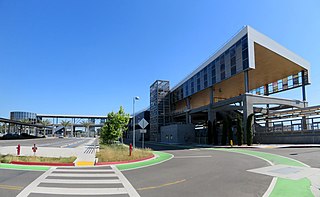
Bay Area Rapid Transit (BART) is a rapid transit system serving the San Francisco Bay Area in California. BART serves 50 stations along six routes and 131 miles of track, including a 9-mile (14 km) spur line running to Antioch, which uses diesel multiple unit vehicles, and a 3-mile (4.8 km) automated guideway transit line serving Oakland International Airport. With an average of 160,300 weekday passengers as of the second quarter of 2023 and 41,286,400 annual passengers in 2022, BART is the seventh-busiest heavy rail rapid transit system in the United States.

The Transbay Tube is an underwater rail tunnel that carries Bay Area Rapid Transit's four transbay lines under San Francisco Bay between the cities of San Francisco and Oakland in California. The tube is 3.6 miles (5.8 km) long, and attaches to twin bored tunnels. The section of rail between the nearest stations totals 6 miles (10 km) in length. The tube has a maximum depth of 135 feet (41 m) below sea level.

Powell Street station is a combined BART and Muni Metro rapid transit station in the Market Street subway in downtown San Francisco. Located under Market Street between 4th Street and 5th Street, it serves the Financial District neighborhood and surrounding areas. The three-level station has a large fare mezzanine level, with separate platform levels for Muni Metro and BART below. The fare mezzanine also connects to the Union Square/Market Street station. The Powell-Mason and Powell-Hyde cable car lines turn around at Powell and Market adjacent to the station and Hallidie Plaza.

The San Francisco Municipal Transportation Agency is an agency created by consolidation of the San Francisco Municipal Railway (Muni), the Department of Parking and Traffic (DPT), and the Taxicab Commission. The agency oversees public transport, taxis, bicycle infrastructure, pedestrian infrastructure, and paratransit for the City and County of San Francisco.

Balboa Park station is a Bay Area Rapid Transit (BART) station and Muni Metro complex in the Mission Terrace neighborhood of San Francisco, California, located near the eponymous Balboa Park. It is an intermodal hub served by four BART routes, three Muni Metro lines, and a number of Muni bus routes. The station complex also includes two rail yards, Cameron Beach Yard and Green Light Rail Center, where Muni maintains Muni Metro trains and heritage streetcars. BART uses a below-grade island platform on the west side of the complex; Muni Metro routes use several smaller side platforms located on surface-level rail loops around the yards.

Pleasant Hill/Contra Costa Centre station is a Bay Area Rapid Transit (BART) station serving the Contra Costa Centre Transit Village in Contra Costa Centre, California, just north of Walnut Creek and just east of Pleasant Hill.

Fremont station is a Bay Area Rapid Transit (BART) station in the central district of Fremont, California. The station is served by the Orange Line and Green Line. It was the southern terminus of both lines from September 11, 1972, until March 25, 2017, when Warm Springs/South Fremont station opened.
Richard A. White is an American public transportation official who served as the CEO and General Manager of the Washington Metropolitan Area Transit Authority during 1996–2006. Prior to joining WMATA as CEO, he served as the general manager at Bay Area Rapid Transit in the San Francisco area. White also spent six years with the federal Urban Mass Transit Administration, which is now the Federal Transit Administration. White is from Massachusetts.

The government of the City and County of San Francisco utilizes the "strong mayor" form of mayoral/council government, composed of the Mayor, Board of Supervisors, several elected officers, and numerous other entities. It is the only consolidated city-county in California, and one of only thirteen charter counties of California. The fiscal year 2019–20 city and county budget was approximately $12.3 billion.
Throughout the history of Bay Area Rapid Transit, there have been plans to extend service to other areas.
Bay Area Rapid Transit, widely known by the acronym BART, is the main rail transportation system for the San Francisco Bay Area. It was envisioned as early as 1946 but the construction of the original system began in the 1960s.

Carole Ward Allen is an American politician, professor, and political consultant. She is a member of the Democratic Party, and serves as the chief executive officer of CWA Partners, LLC. As a mass transportation executive in the State of California, Ward Allen served three four-year terms as an elected member of the San Francisco Bay Area Rapid Transit District Board of Directors representing the 4th district from 1998 until 2010.

Berryessa/North San José station is an intermodal transit center located in the Berryessa district of San Jose, California. The station is served by Bay Area Rapid Transit (BART) and Santa Clara Valley Transportation Authority (VTA) buses. The transit center opened for bus service on December 28, 2019, and subsequently for BART service on June 13, 2020.

eBART is a hybrid rail branch line of the Bay Area Rapid Transit (BART) system in eastern Contra Costa County, California, United States. The line extends the Yellow Line beyond Pittsburg/Bay Point station to Antioch station.

The San Francisco Bay Area Rapid Transit District, or BART, is a special-purpose district body that governs the Bay Area Rapid Transit system in the California counties of Alameda, Contra Costa and San Francisco. The system itself also serves northern San Mateo County and Santa Clara County; however, these counties have bought into the system and have neither a voting stake nor any representatives in the district proper. The District currently operates 50 stations, 817 rail cars, 131 miles of track

Warm Springs/South Fremont station is a Bay Area Rapid Transit (BART) station located in the Warm Springs district of Fremont, California. The station is served by the Orange Line and Green Line. It was the southern terminus of both lines from its opening on March 25, 2017 until June 13, 2020, when Milpitas and Berryessa/North San José stations opened as part of the Silicon Valley BART extension.

The Oakland Airport Connector is an automated guideway transit (AGT) system operated by Bay Area Rapid Transit (BART) between BART's Coliseum station and Oakland International Airport station. The line is colored on BART maps as the Beige Line. The system is integrated into BART's fare system. The line opened for revenue service on November 22, 2014, replacing the AirBART shuttle bus service that had operated since July 1, 1977. Currently operating between two terminal stations, the system includes provisions for an intermediate third station that may be built at a later date.
Bill "Billy" Richard Stokes was a mass transportation specialist and advocate most famous for being the General Manager of the San Francisco Bay Area Rapid Transit (BART) District during the initial construction and start of service of BART.
Dorothy W. Dugger is a mass transportation specialist who worked for the San Francisco Bay Area Rapid Transit (BART) district from 1992 to 2011, spending the last four years as BART's first female general manager.
Thomas E. "Tom" Margro is a mass transportation specialist best known for being the longest-serving General Manager for the San Francisco Bay Area Rapid Transit district. He also served as CEO of the Transportation Corridor Agencies from 2007 to 2012.















